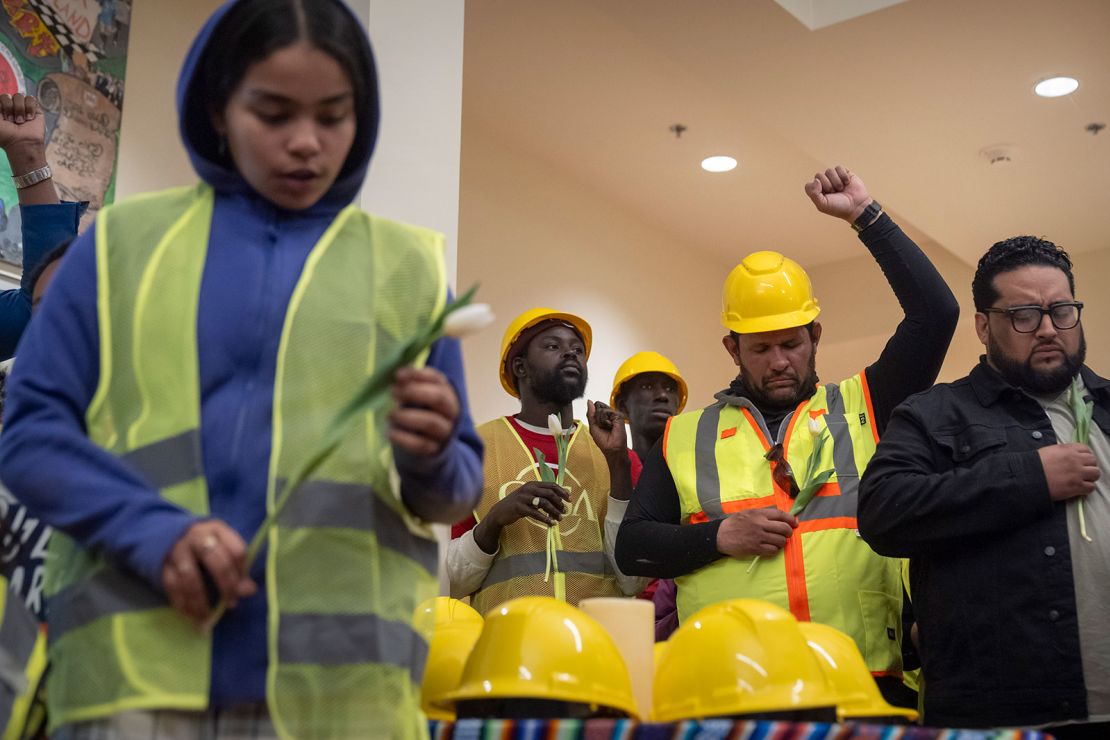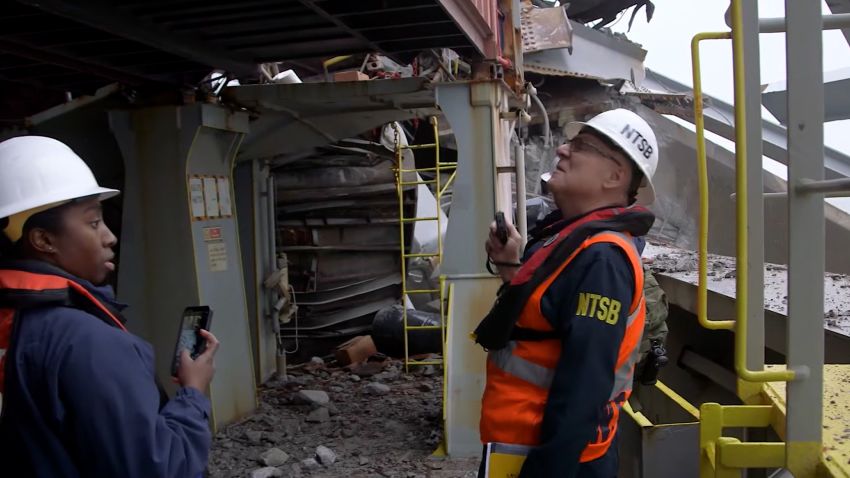It could take weeks for the Port of Baltimore to reopen, according to the US Army Corps of Engineers, as an arduous cleanup process to clear the massive wreckage from this week’s catastrophic bridge collapse begins, leaving commuters and workers in limbo and supply chains in disarray.
The Chesapeake 1000 – the largest crane on the East Coast – arrived Friday to help clear debris from where a 213-million-pound cargo vessel slammed into the Francis Scott Key Bridge, destroying the vital thoroughfare and killing six construction workers. Four of their bodies have not been found.
Crews will try to work quickly so the search for the missing victims can resume and a cargo channel critical to the local and national economies can reopen, authorities said.
“I don’t think we’re talking days, I don’t think we’re talking months … I think we’re talking weeks,” said Scott Spellmon, commanding general of the US Army Corps of Engineers, of the cleanup effort and the reopening of the channel. “I just can’t put a number on it yet until we get our analysis complete.”
Maryland Gov. Wes Moore said on Saturday that the cargo ship’s hull is damaged but intact, and that the Army Corps and its partners will move forward with crane operations.
“The north sections of the Key Bridge are going to be cut up and removed,” Moore said on Saturday. “This will eventually allow us to open up a temporary restricted channel that will help us to get more vessels in the water around the site of the collapse.”
The first lift of a portion of the bridge is expected to happen sometime on Saturday, according to officials.
“Crews are out today working every part of the northside of the bridge that remains, the first piece could be removed and dropped off to trade point Atlantic, as soon as today,” Paul Wiedefeld, secretary of the Maryland Department of Transportation, said on Saturday.
Rear Adm. Shannon Gilreath of the US Coast Guard said the initial lift marks the beginning of a long process toward reopening the port to tug and barge traffic.
“Much like when you run a marathon, you’ve got to take the first few steps,” Gilreath said.
Ongoing cleanup efforts have included isolating a section of an underwater natural gas pipeline, the Baltimore Gas and Electric Company told CNN in an email Saturday.
A spokesperson said the company has “intentionally released gas from that section as a proactive safety measure in support of the salvage operations” near the bridge.
The work has not resulted in customer impacts or safety concerns, according to the spokesperson.
It could take days to examine the area before the first piece of the massive wreckage is cut and lifted out of the way, Spellmon told CNN Friday. More than 1,000 engineers in Baltimore and across the country are studying the wreckage piece-by-piece to figure out the best plan to remove it.
To help with this massive task, more heavy equipment is expected at the scene in the coming weeks. That includes seven floating cranes, 10 tugs, nine barges, eight salvage vessels and five Coast Guard boats, Moore said.
Workers at the scene still face “an incredibly complex job,” Moore said Thursday.
“When you have a chance to see that wreckage up close, you fully understand the enormity of the challenge,” the governor said. “Our timeline will be long.”
The cargo ship – about the length of three football fields – has as much as 4,000 tons of steel from the bridge’s frame hanging on its bow.
Authorities believe the remaining four victims are trapped in the tangle of steel and concrete underwater. Recovering those victims is a top priority, and it is “our obligation to bring a sense of closure to these families,” Moore said.
In addition to the human toll, the economic fallout of the bridge collapse could be wide-ranging as it has indefinitely halted the flow of ships in and out of the Port of Baltimore and delivered a stunning blow to the thousands of dock workers who rely on the busy port.
The port is the largest in the US for cars and light trucks, handling a record 850,000 vehicles last year, Moore said. “The port handles more cars and more farm equipment than any other port in America and at least 8,000 workers on the docks have jobs that have been directly affected by this collapse,” he added.
“Our economy depends on the Port of Baltimore and the Port of Baltimore depends on vessel traffic,” Moore said Friday.
“Maryland’s economy and Maryland’s workers rely on us to move quickly but that’s not just Maryland. The nation’s economy and the nation’s workers are requiring us to move quickly.”
On Saturday, Moore announced the US Small Business Administration accepted his disaster declaration request for federal loan assistance. The funds are low interest and are for up to $2 million, Moore said.
Immigrant advocacy group notes dangers workers face ‘so our lives are made easier’

CASA, an organization that provides services to working-class and immigrant families, stressed the dangers construction workers face after six men died when the Francis Scott Key Bridge collapsed.
The victims, originally from Mexico, Guatemala, El Salvador and Honduras, were filling potholes on the bridge when it was hit by a container ship on Tuesday.
CASA Executive Director Gustavo Torres said essential workers, like the men on the bridge, perform dangerous yet critical work at significant personal risk.
“These workers who make it possible to get to work … who work at night and it in the cold and throughout the pandemic — so our lives are made easier,” Torres said.
The bodies of Alejandro Hernandez Fuentes, of Mexico, and Dorlian Ronial Castillo Cabrera, of Guatemala, have been recovered, officials said earlier this week. Authorities paused recovery efforts for the four others because concrete and other debris made it unsafe for divers.
Two of the workers whose bodies have not yet been recovered were part of the organization — father of three Miguel Luna and father of two Maynor Suazo Sandoval, according to CASA.
As crews work at the site of the collapse, families of the men who were on the bridge have been grappling with losing their loved ones and struggling to find closure as they wait to be reunited with them.
Carlos Hernández, a 24-year-old from Mexico, sent his girlfriend a voice memo from the bridge minutes before the collapse.
“Yes, my love, we just poured the cement and we’re just waiting for it to dry,” Hernández told Jazmin Alvarez, according to the voice note she shared with CNN affiliate Univision.
Hernández’s mother, Lucia Zambrano, told Univision she’s asking for help getting a humanitarian visa so she can travel to Maryland, be with her son and exert pressure to keep searching for him.
“I wake up, I want to think I am dreaming, but wake up and I know this is reality – that my son was there,” Zambrano said.
In Dundalk, Maryland, the Owls Corner Café is rallying behind one of its employees, whose husband – Jose Mynor Lopez – has been missing since the bridge collapsed. Lopez’s wife, Isabel Franco, works for the cafe, according to owner Lilly Ordonez. The business started a GoFundMe page for Franco and her family, writing that Lopez’s family now faces an “uncertain future” without its “main provider and pillar of strength.”
CNN’s Elizabeth Wolfe and Holly Yan contributed to this report.




